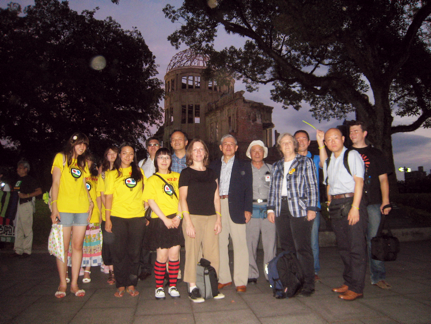Greetings from Hiroshima! By Alicia Godsberg, Executive Director Peace Action NYS
This picture was taken with some of the others in the Gensuikin conference in front of the atomic dome, which was one of the only burned out things left standing 66 years ago today after the first atomic bomb ever was detonated in war over Hiroshima on August 6, 1945 at 8:15 a.m.
The conference has been amazing so far, and tomorrow we are leaving for Nagasaki for the second of three stages of the conference. Today, the anniversary of the bombing, there was a ceremony attended by at least 20,000 people in the Peace Park, near the atomic dome. Prime Minister Kan spoke, and I was surprised to hear him say that he “regretted believing in the myth of the safety of nuclear power.” The ongoing disaster at Fukushima resonates heavily here, with the fears of radiation exposure renewed.
The Prime Minister also stated that Japan was going to review its energy policy from scratch, with the hope of ending reliance on nuclear power. Most speakers I’ve heard so far have related the accident at Fukushima’s nuclear power plants to the August 6 commemorations, and in fact I was asked to give my speech about nuclear power for this reason.
Also of note is the fact that many speakers have criticized the recent sub-critical nuclear tests conducted by the U.S., which is something not too many American anti-nuclear organizations talk about. Sub-critical nuclear experiments enable scientists to conduct nuclear reactions in the lab that do not go “critical,” or achieve a sustaining chain nuclear reaction. They are part of the Stockpile Stewardship Program (SSP) of the Department of Energy, which is the fancy name given to the life extension programs for nuclear weapons at the national labs. The SSP was started under the Clinton administration to appease members of Congress so that they would feel confident in the robust character of our nuclear stockpile under a self-imposed nuclear test ban.
The U.S. has stated that even under the CTBT sub-critical nuclear tests would be permitted, although this is something Russia and many other states are concerned about (even though Russia also conducts these tests). The value of sub-critical nuclear tests to the nuclear weapon states is questionable at best, but they would be valuable experiments for would-be nuclear weapon states, and that’s why they should be banned under the CTBT and stopped immediately by the U.S. and Russia.
I’m guessing so many people in Japan are concerned about these tests because it is part of a means of keeping nuclear weapons in perpetuity, studying the affects of aging on the weapons’ nuclear material to make sure it remains “good” into the indefinite future. People in the U.S. should be concerned not only because this program poses a huge international security risk if it were to be tolerated under a CTBT, but also because billions of dollars are funneled into the national labs for these tests, which are not of critical national security significance.
But I am digressing… I’m writing about Japan! I don’t think I will ever forget the feeling of 8:15 a.m. this morning, when bells solemnly rang to commemorate the moment when the bomb detonated over this very city, destroying everything and most living creatures. Hearing the stories of the Hibakusha themselves on this day was a painful reminder of the terrible consequences of this awful event, which is really too awful for our minds to fully comprehend.
I think the inconceivable nature of the destruction, damage, pain, and suffering from the use of nuclear weapons is one of the main reasons people don’t focus on them as an immediate danger that needs to be eliminated, and eliminated now. If Mayor Bloomberg were in Hiroshima today, I would defy him to remain against becoming a Mayor for Peace.
It is impossible to be unmoved by being here on this day, especially as an American, but mostly as a human being. Hearing school children deliver a speech saying “each one of us is important” and that “we should not kill each other” brought tears to my eyes. It makes me sad for all my friends at Iraq Veterans Against the War and for all the people suffering from the useless wars in which our country is now engaged.
Seeing the atomic dome in person is also quite moving. As someone who has studied nuclear weapons and has worked for their elimination for some time, I have read about Hiroshima and seen pictures of this dome in countless books and articles. Seeing it in front of me in its ruinous state and imagining that moment when the bomb exploded and everything turned black was a very emotional moment for me. After the picture above was taken, a few hundred people held hands and surrounded the dome, raising our arms each time as we said “No More Hiroshima, No More Nagasaki, No More Hibakusha, No More Fukushima!” This is another moment I will never forget.
Tonight was the lantern lighting ceremony, where people write their own message of peace and float their lanterns down one of this city’s many rivers. I went with an Australian friend of mine who is here for the other big anti-nuclear conference in Hiroshima – his name is Tim and he works for the International Campaign Against Nuclear Weapons (ICAN), which is an Australian NGO that is working on getting support for a nuclear weapon convention. A lot of young people are involved in ICAN, and Tim and I had a great discussion about bringing more young people into Peace Action and about the importance of board members having different skills so that they can help not only grow the organization financially, but also bring their contacts to help in other fields, such as media outreach.
We sent our lanterns off together into the river with so many others and with them our message for peace and the abolition of nuclear weapons -not sometime in the unknown future, but now, and for good.
Alicia can be reached at alicia@panys.org



